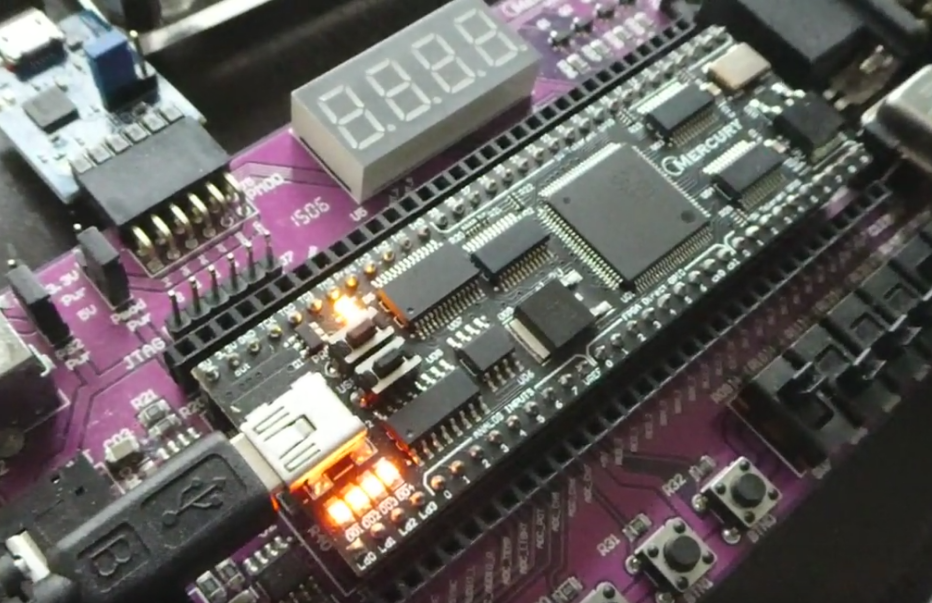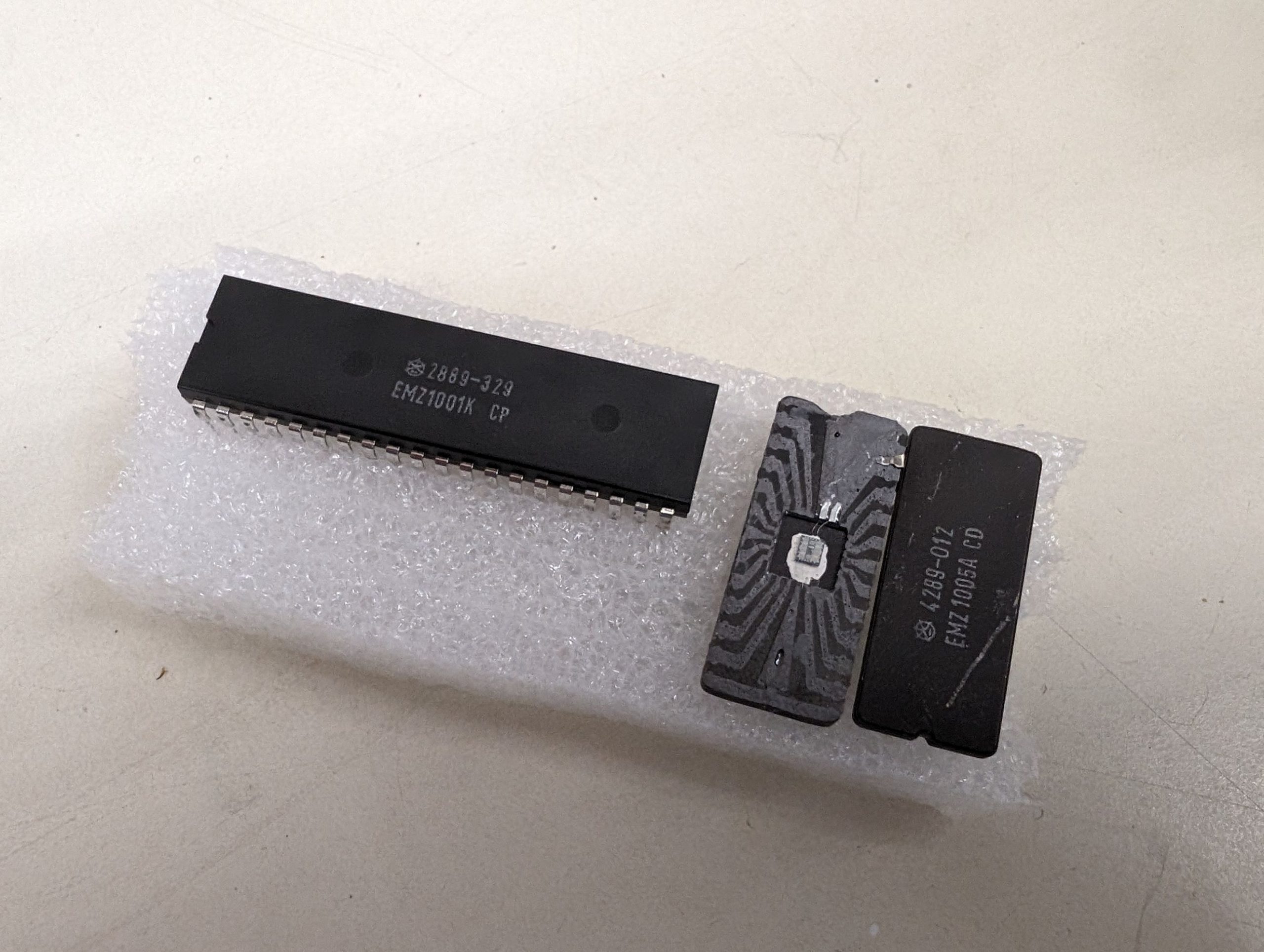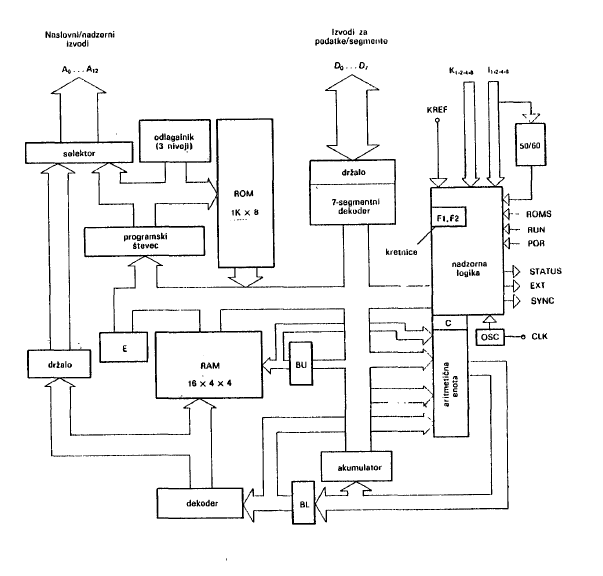In the laboratory of the Computer History Museum Slovenia, we decided to dig among our old devices to locate Iskra's 4-bit microcontroller, or microcomputer (as they were commonly called back then), the EMZ-1001, which was developed and designed at the Faculty of Electrical Engineering between 1975 and 1977.
As promised, we continue with a photo of the EMZ-1001K circuit and a few other interesting things we discovered along the way.
Microscopic photo of the EMZ-1001K
We sent the Iskra EMZ-1001K and EMZ-1005A circuits to researcher Travis Goodspeed in the USA. He opened them for us and took microscopic photographs of the actual content of the chip on the silicon wafer (silicon die). The image clearly shows different areas of the microcontroller, its “brain lobes.” The microcontroller, in addition to the central processing unit, includes a control unit, input-output unit, and memory. The largest network visible in the image is the read-only memory, on which the appropriate software (Mask ROM) was written at the time of production using a lithographic process. The smaller one is its working memory (RAM).

The EMZ-1001 is made using the 5-micron NMOS technology of American Microsystems Incorporated (AMI). In the late 1970s, Iskra acquired a license for this technology and then introduced it in 1983 at their factory Iskra Mikroelektronika in Stegne. Prior to that, they had been manufacturing circuits on silicon wafers in the USA for several years (EMZ-1001, EMZ-1002, EMZ-1005A/B, and others). The license for the domestic production of the circuits and the import of the strictly controlled manufacturing technology was obtained by Iskra thanks to the excellent design work of the experts from the Microelectronics Laboratory at the Faculty of Electrical Engineering.
Prior to that, in 1975, they had purchased a license from the company, but it only included the design of custom monolithic circuits (MOS), their assembly, and testing. At that time, our experts were also training in Silicon Valley in the design of monolithic integrated circuits for special purposes. In a joint design team with experts from AMI, between 1975 and 1978, they developed, among other things, the microcontroller in question, the EMZ-1001, or AMI S2000, as it was called by the American partner.
In 1980, Iskra sold a standard version of its EMZ-1001 in small quantities at a price of around 550 dinars, with the price being lower for larger batches. The cost of producing 5,000 units, including the creation of a custom program mask, was approximately 6,000 dollars. The production of the program mask took 2-3 months.

Versions of the microcontroller
The EMZ-1001 microcontroller with the K suffix, which we sent for imaging in the USA, is identical to the standard version of the microcontroller, except it is designed for use in the most demanding temperature conditions (from -40 to 85 degrees Celsius). This version is primarily used in industry and for military purposes. Three more affordable versions were produced: the 1001B with a range of 0-55 degrees, the 1001C with a range of 0-70 degrees, and the 1001E with a range of 0-85 degrees Celsius.
The standard version of the microcontroller supported the use of segmented LED displays, while the special version, the EMZ-1001A, also allowed the use of fluorescent VFD displays. Later, the company AMI, which was a co-owner of the circuit, developed more powerful versions of the microcontroller, namely the AMI S-2150, S-2200, and S-2400, with expanded RAM (320, 512 B) and ROM (1.5, 2, and 4 KB), as well as some other significant updates. Iskra did not manufacture these versions.
You can find more about this at the following link: https://www.cpushack.com/2023/06/13/the-4-bit-eight-bit-processor-ami-s2000-and-iskra-emz1001/
A detailed description of the architecture and operation can be found in Dušan Raič’s article: Integrirani mikroračunalnik Iskra EMZ-1001 (on page 14): https://www.dlib.si/stream/URN:NBN:SI:DOC-IOE5F5GH/dbc07a6f-2548-45a6-ab4d-b5f9da2dd170/PDF
We also recommend the article by Davor Miljan: Projektiranje z integriranimi mikroračunalniki (on page 31), which more thoroughly discusses the areas and methods of using microcontrollers: https://www.dlib.si/stream/URN:NBN:SI:DOC-VN9TV8FP/7ccbe455-72b2-4b31-aaea-4f6896701851/PDF
The Iskra EMZ-1001A Emulation Project
We also present an interesting emulation project.
Zoltan Pekič, with the help of a device featuring a programmable logic array (FPGA) of the MicroNova Mercury Baseboard type (LINK), created a simulation of the Iskra EMZ-1001A microcontroller. He demonstrated the implementation and operation of the microcontroller with a simple program that displays the text “Hello world” on a seven-segment LED display and a program that calculates the Fibonacci sequence.

Video of the project: https://youtu.be/Bn3rqHyoyjo
For more information, visit the project website: https://hackaday.io/project/188614-iskra-emz1001a-a-virtual-resurrection or at https://github.com/zpekic/sys_emz1001/tree/main
Devices with programmable logic arrays (FPGA) are made up of a series of logic blocks that can be programmatically adjusted to perform various digital functions. In this way, they can emulate the operation of all types of logic and memory digital circuits, making them extremely useful for creating and testing prototypes. Today, emulating old hardware with these devices is even easier, as the necessary adjustments can be automatically made by software based on the specifications of the emulated device.
Emulation is becoming an important part of preserving computer heritage. Zoltan Pekič’s project beautifully demonstrates one of the possible ways to recreate and revive old hardware. The operation of past hardware can also be quite faithfully emulated on modern devices using purely software solutions. With such software emulators, we can successfully revive old software as well.
Written by Marko Štamcar, Head of Museum Laboratory
References
EMZ-1001 on Wikipedia.hr (LINK) | Brochure for EMZ-1001 (LINK) | AMI S2000 Family datasheet (LINK) | AMI S2000 Programing manual (LINK) | Article The four bit eight bit processor AMI S2000/Iskra EMZ-1001 (LINK) | AMI S2000 specifications on CPUWorld (LINK) | Electronic Design no.3, 1978: Advertisement for AMI S2000 and associated development tools on pages 80 and 81 (LINK)

